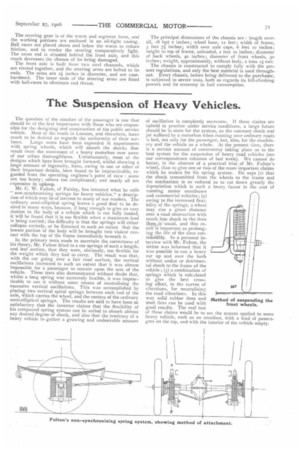The Suspension of Heavy Vehicles.
Page 25

If you've noticed an error in this article please click here to report it so we can fix it.
The question of the comfort of the passenger is one that should be of the first importance with those who are responsible for the designing and construction of the public service vehicle. Most of the roads in London, and elsewhere, leave much to be desired as regards the uniformity of their surfaces. Large sums have been expended in experiments with spring wheels, which will absorb the shocks that result from the movement of .1 heavy motorbus over SOITIC of our urban thoroughfares. Unfortunately, most of the designs which have been brought forward, whilst showing a large amount of ingenuity, have, owing to one or other of their important details, been found to be impracticable, regarded from the operating engineer's point of view : some are too heavy; others too complicated; and nearly all are expensive in upkeep. Mr. C. W. Fulton, of Paisley, has invented what he calls "non-synchronising springs for heavy vehicles," a description of which may be of interest to many of our readers. The ordinary semi-elliptical spring leaves a good deal to be desired in many ways, because, if long enough to give an easy motion to the body of a vehicle which is not fully loaded, it will be found that it is too flexible when a maximum load is being carried; the difficulty is that the springs will either collapse entirely, or be flattened to such an extent thit the lowest portion of the body will be brought into violent contact with the top of the frame immediately beneath it.
In the primary tests made to ascertain the correctness of his theory, Mr. Fulton fitted to a car springs of such a length, and leaf section, that they were, obviously, too flexible for the weight which they had to carry. The result was that, with the car going over a fair road surface, the vertical oscillations increased to such an extent that it was almost impossible for a passenger to remain upon the seat of the vehicle. These tests also demonstrated without doubt that, whilst a long spring was extremely flexible, it was impracticable to use it without some means of neutralising the excessive vertical oscillations. This was accomplished by placing two vertical spiral springs between each end of the axle, which carries the wheel, and the centres of the ordinary semi-elliptical springs. The results are said to have been so satisfactory that the inventor claims that the flexibility of his compound spring system can be suited to absorb almost any desired degree of shock, and also that the tendency of a heavy vehicle to gather a growing and undesirable amount of oscillation is completely overcome. If these claims are upheld in practice under service conditions, a large future should be in store for the system, as the constant shock and jar suffered by a motorbus when running over ordinary roads is bad, not only for the passenger, but, also, for the machinery and the vehicle as a whole. At the present time, there is a certain amount of controversy taking place as to the best system for the suspension of heavy road vehicles (see our correspondence columns of last week). We cannot do better, in the absence of a practical trial of Mr. Fulton's wheel, than to give one or two of the more important claims which he makes for his spring system. He says (t) that the shock transmitted from the wheels to the frame and the mechanism is so reduced as to cut down greatly the depreciation which is such a heavy factor in the cost of running motor omnibuses and commercial vehicles; (2) owing to the increased flexibility of the springs, a wheel may rise a given distance over a road obstruction with much less shock to the tires than is usual, and this result is important as prolonging the life of the tires consideably. In a personal interview with Mr. Fulton, the writer was informed that it was possible to run a heavy car up and over the kerb without undue or detrimental shock to the frame of the vehicle ; (3) a combination of springs which is calculated to give the best crossing effect, in the curves of vibrations, for neutralising the road vibrationc. In this way solid rubber tires and steel tires can be used with good results. The real test of these claims would be to see the system applied to some heavy vehicle, such as an omnibus, with a load of passengers on the top, and with the interior of the vehicle empty. Method of suspending the front wheels.


























